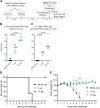Protective effects of an mRNA vaccine candidate encoding H5HA clade 2.3.4.4b against the newly emerged dairy cattle H5N1 virus
- PMID: 39481207
- PMCID: PMC11565041
- DOI: 10.1016/j.ebiom.2024.105408
Protective effects of an mRNA vaccine candidate encoding H5HA clade 2.3.4.4b against the newly emerged dairy cattle H5N1 virus
Conflict of interest statement
Declaration of interests Sh,Y., K.S., Y.O., A.Y., S.M., N.J., and F.T are employees of Daiichi Sankyo Co., Ltd. Y.K. has received unrelated funding support from FUJIFILM Toyama Chemical Co., Ltd.; TAUNS Laboratories, Inc.; Shionogi & Co., Ltd.; Otsuka Pharmaceutical Co., Ltd.; KM Biologics Co., Ltd.; Kyoritsu Seiyaku Corporation; Shinwa Corporation; and Fujirebio Diagnostics. Y.K. is also a co-founder of FluGen, Inc.
Figures


References
-
- CDC confirms three human cases of H5 bird flu among Colorado poultry workers. 2024. https://www.cdc.gov/media/releases/2024/s0725-three-human-cases-of-h5-bi...
-
- CDC confirms second human H5 bird flu case in Michigan; third case tied to dairy outbreak. 2024. https://www.cdc.gov/media/releases/2024/p0530-h5-human-case-michigan.html
-
- Highly pathogenic avian influenza A (H5N1) virus infection reported in a person in the U.S. 2024. https://www.cdc.gov/media/releases/2024/p0401-avian-flu.html
-
- Federal and State Veterinary Public health agencies share update on HPAI detection in Kansas. Texas Dairy Herds. 2024 https://www.aphis.usda.gov/news/agency-announcements/federal-state-veter...
-
- CDC confirms human cases of H5 bird flu among Colorado poultry workers. 2024. https://www.cdc.gov/media/releases/2024/p-0715-confirm-h5.html
LinkOut - more resources
Full Text Sources

